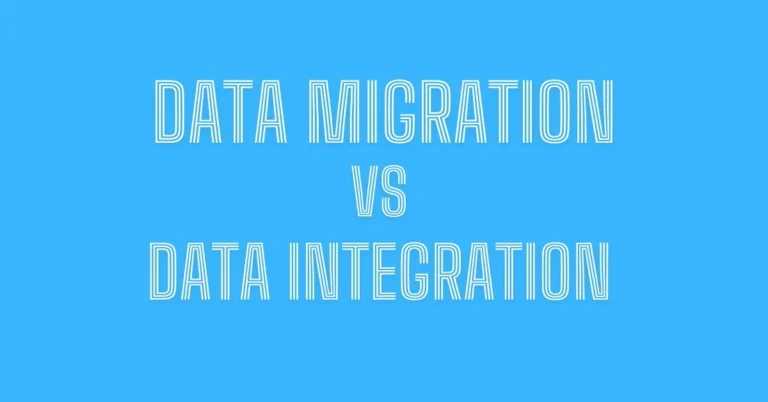INTRODUCTION
In today’s data-driven world, businesses are constantly faced with the challenge of managing their information effectively. Two terms often come up in this landscape: data migration and data integration. While they sound similar, they serve distinct purposes that can significantly impact your organization’s success. Understanding these concepts is essential for data migration vs data integration looking to streamline its operations and harness the power of its data.
Whether you’re planning to move your databases to the cloud or aiming to connect multiple systems seamlessly, knowing when and how to implement each process can make all the difference. This guide unpacks everything you need to know about data migration vs data integration—helping you navigate these crucial aspects of modern business management with confidence. Let’s dive in!
Understanding Data Migration and Data Integration
Data migration involves transferring data from one system to another. This can include moving data between storage locations, databases, or applications. The primary goal is often to enhance performance, upgrade systems, or consolidate information.
On the other hand, data integration focuses on combining data from different sources into a unified view. This process ensures that various systems work together seamlessly. It allows organizations to access and analyze their information holistically.
Both processes play critical roles in managing an organization’s data landscape. However, they cater to different business needs and objectives. Understanding these nuances helps businesses make informed decisions about which approach aligns best with their goals and challenges.
Key Differences between Data Migration and Data Integration
Data migration and data integration serve different purposes in the realm of data management. Data migration involves moving data from one storage system to another. This transition can be driven by upgrades, consolidations, or changes in business needs.
On the other hand, data integration is about combining information from various sources into a unified view. It helps organizations access comprehensive insights without altering the original datasets.
Another key difference lies in their time frames. Migration typically occurs as a one-time event or during significant updates. Integration is often an ongoing process that continuously incorporates new data.
The tools used for each task also differ significantly. Migration tools focus on transferring and converting existing datasets, while integration solutions emphasize connecting disparate systems and ensuring real-time accessibility.
Understanding these distinctions is crucial for businesses aiming to optimize their data strategies effectively.
ALSO READ: Noblocc: Redefining the Future of Connectivity
Pros and Cons of Data Migration and Data Integration
Data migration offers significant advantages. It allows businesses to consolidate data into a single system, enhancing efficiency and accessibility. The process can improve performance by eliminating redundancies.
However, it’s not without challenges. Data loss or corruption during the transfer is a common risk that organizations must manage carefully. Additionally, downtime can occur, affecting operations temporarily.
On the other hand, data integration provides real-time access to information across various systems. This capability fosters better decision-making since users have immediate insights at their fingertips.
Yet, integrating diverse data sources can become complex and costly. Ensuring compatibility between different systems often requires substantial investment in time and resources.
Both approaches come with their own sets of benefits and drawbacks that need careful consideration based on organizational needs and goals.
Factors to Consider before Choosing between the Two
Choosing between data migration and data integration requires careful thought. Start by assessing your business needs. Are you looking to move data from one system to another, or do you need multiple systems to communicate seamlessly?
Consider the complexity of your current infrastructure. If it involves numerous applications, integration may be more beneficial for ongoing operations.
Budget constraints also play a significant role. Data migration often incurs higher upfront costs due to the need for specialized tools and services, while integration may require continuous investment in maintaining connections between systems.
Evaluate timelines as well. A quick turnaround might favor migration if you’re on a tight schedule, whereas a longer-term approach could allow for effective integration strategies that enhance overall functionality.
Think about future growth. Will your organization expand? Choosing an adaptable solution can help accommodate evolving data needs down the line.
Best Practices for Successful Data Migration and Integration
Successful data migration and integration require meticulous planning. Begin with a solid strategy that outlines your objectives and timelines. Knowing what you want to achieve will guide every step of the process.
Data quality is paramount. Before migrating or integrating, cleanse your data. Remove duplicates and fix inaccuracies to ensure only reliable information enters your new system.
Testing should never be overlooked. Conduct comprehensive tests during both migration and integration phases. This helps identify potential issues early on, saving time and resources later.
Documentation also plays a vital role in success. Keep detailed records of processes, configurations, and any challenges encountered along the way for future reference.
Involve all stakeholders throughout the journey. Their insights can provide valuable perspectives that enhance overall effectiveness while fostering collaboration across teams.
ALSO READ: Digital Dynamo: Unveiling iLikeCPMix
Real-Life Examples of Successful Data Management Strategies
Many organizations have harnessed the power of effective data migration and integration. For instance, a leading retail chain successfully migrated its customer database to a new cloud-based platform. This move improved their analytics capabilities, allowing for personalized marketing strategies that increased sales.
In another example, an educational institution integrated various student information systems. By consolidating data from admissions, course management, and financial aid into one cohesive system, they enhanced communication and streamlined processes.
A healthcare provider took on both migration and integration by transferring patient records from legacy systems to a modern electronic health record (EHR) system. This not only improved patient care but also ensured compliance with regulations.
Each case shows how strategic approaches to data management can lead to significant operational improvements while enhancing user experiences across different sectors.
Conclusion
Data migration and data integration are both critical concepts in the realm of data management. Understanding their nuances can significantly impact an organization’s efficiency and success. While data migration focuses on transferring data between systems, data integration emphasizes connecting disparate sources to provide a unified view.
The differences between these two processes shape how companies manage their information assets. Each approach has its own set of advantages and challenges, making it essential for businesses to evaluate which method aligns best with their goals.
When deciding between data migration and integration, several factors come into play—such as existing infrastructure, business requirements, costs involved, and long-term strategic plans. Considering these elements ensures that organizations make informed choices tailored to their unique circumstances.
Implementing best practices is vital for achieving successful outcomes in either scenario. Organizations should prioritize thorough planning, testing phases, quality assurance measures, and ongoing monitoring to mitigate risks often associated with large-scale data projects.
Real-life examples illustrate the effectiveness of sound strategies when handling complex datasets. Companies that have successfully navigated these waters often share common themes: they prioritize collaboration across departments while embracing innovation throughout the process.
Having a clear understanding of what each process entails empowers organizations to leverage their data effectively—transforming potential challenges into opportunities for growth and enhanced decision-making capabilities.
ALSO READ: Xatpes: Pioneering Tomorrow’s Conversations
FAQs
What is Data Migration vs Data Integration?
Data migration refers to transferring data from one system to another, often to enhance performance or consolidate systems. Data integration, on the other hand, involves combining data from various sources into a unified view to enable seamless access and analysis across systems.
When Should I Use Data Migration?
Use data migration when you need to move data between systems or platforms, such as upgrading to a new database, consolidating information, or transitioning to cloud storage. It’s typically a one-time or infrequent process.
What Are the Key Benefits of Data Integration?
Data integration provides real-time access to data from multiple sources, enhancing decision-making and operational efficiency. It helps create a cohesive view of information without altering the original datasets, facilitating better analysis and reporting.
What Risks Are Associated with Data Migration?
Risks include data loss or corruption during transfer, system downtime, and compatibility issues. Careful planning, testing, and using reliable tools can help mitigate these risks.
How Can I Decide Between Data Migration and Data Integration?
Consider your business needs and goals. Data migration is suited for moving or consolidating data, while data integration is ideal for combining information from different systems for a unified view. Assess factors like complexity, budget, and long-term objectives to choose the best approach.

